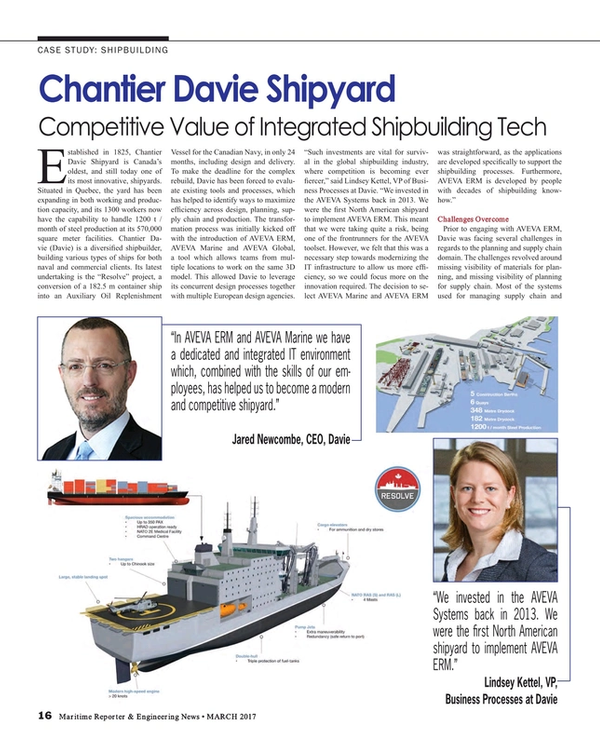
Chantier Davie Shipyard: Competitive Value of Integrated Shipbuilding Tech
Case study: Chantier Davie Shipyard invests in AVEVA technology to keep competitive.
Established in 1825, Chantier Davie Shipyard is Canada’s oldest, and still today one of its most innovative, shipyards. Situated in Quebec, the yard has been expanding in both working and production capacity, and its 1,300 workers now have the capability to handle 1,200 t / month of steel production at its 570,000 square meter facilities. Chantier Davie (Davie) is a diversified shipbuilder, building various types of ships for both naval and commercial clients. Its latest undertaking is the “Resolve” project, a conversion of a 182.5 m container ship into an Auxiliary Oil Replenishment Vessel for the Canadian Navy, in only 24 months, including design and delivery. To make the deadline for the complex rebuild, Davie has been forced to evaluate existing tools and processes, which has helped to identify ways to maximize efficiency across design, planning, supply chain and production. The transformation process was initially kicked off with the introduction of AVEVA ERM, AVEVA Marine and AVEVA Global, a tool which allows teams from multiple locations to work on the same 3D model. This allowed Davie to leverage its concurrent design processes together with multiple European design agencies. “Such investments are vital for survival in the global shipbuilding industry, where competition is becoming ever fiercer,” said Lindsey Kettel, VP of Business Processes at Davie. “We invested in the AVEVA Systems back in 2013. We were the first North American shipyard to implement AVEVA ERM. This meant that we were taking quite a risk, being one of the frontrunners for the AVEVA toolset. However, we felt that this was a necessary step towards modernizing the IT infrastructure to allow us more efficiency, so we could focus more on the innovation required. The decision to select AVEVA Marine and AVEVA ERM was straightforward, as the applications are developed specifically to support the shipbuilding processes. Furthermore, AVEVA ERM is developed by people with decades of shipbuilding know-how.”
Challenges Overcome
Prior to engaging with AVEVA ERM, Davie was facing several challenges in regards to the planning and supply chain domain. The challenges revolved around missing visibility of materials for planning, and missing visibility of planning for supply chain. Most of the systems used for managing supply chain and planning were homegrown and supplemented with various excel sheets and access databases. Davie started their transition by purchasing SAP for financials and shortly thereafter AVEVA ERM for material management and planning.
“The ERM implementation process gave us a really good start on our continuous improvement journey,” said Lindsey. “There has been quite a steep learning curve as we transitioned between systems. We have not been used to adapting to new business processes in such a rapid and overarching fashion. We are still not using the AVEVA ERM to its full capability, but the integrated planning and materials management functions with AVEVA ERM are helping us to identify and solve problems that no individual would be able to manage on their own with a project moving at this pace.”
One of the challenges which have been overcome is missing materials on the shop floor. As a result of using AVEVA ERM’s integrated planning and materials management capabilities, Davie now has complete status/availability of materials prior to releasing jobs for production with their production teams. This has minimized the requirement for suspending jobs due to missing materials, and because of this, the efficiency of production teams has increased. As a side effect, warehousing also has better visibility of priorities when critical items are received into inventory.
“The traffic light system of both the material status and in the planning module is helping us effectively manage the entire material stream, right from identifying early requirements to purchasing actual materials, then getting those materials on-site and out to Production teams to do their jobs on-time and following the Project schedule, while minimizing material wastage and over or under-buying,” said Lindsey.
Continuous Improvement
Now that Davie has embarked on this journey, they have realized improvements in terms of the visibility of status on jobs and materials. However, Davie recognizes its improvement journey is continuous and attention shall now be placed on other areas of the business. An example is the management of in-house steel and outfit fabrication, a process which so far has been managed and statused in various spreadsheets and databases. Davie handles most of the fabrications in-house, which makes planning and managing this a large task for supply chain, planning and production. The expectation is that by adapting more of the AVEVA ERM functionality, and making internal fabrication status more easily visible downstream, production efficiency will increase significantly.
Facing Future Challenges
AVEVA ERM and AVEVA Marine are also seen as important from a business management point of view. Jared Newcombe, CEO at Davie, agrees that, with these solutions, the shipyard is well placed to face the many challenges which may lie ahead in the shipbuilding industry. “In AVEVA ERM and AVEVA Marine we have a dedicated and integrated IT environment which, combined with the skills of our employees, has helped us to become a modern and competitive shipyard by reducing project cycles and so bringing down our total costs,” Newcombe said.
Also, the excellent collaboration with AVEVA shows us that we are in safe hands, thanks to their expertise and their approach to shipbuilding.”
For more information, visit http://www.aveva.com
(As published in the March 2017 edition of Maritime Reporter & Engineering News)
Read Chantier Davie Shipyard: Competitive Value of Integrated Shipbuilding Tech in Pdf, Flash or Html5 edition of March 2017 Maritime Reporter
Other stories from March 2017 issue
Content
- Cabotage Rules Changes Proposed page: 14
- Chantier Davie Shipyard: Competitive Value of Integrated Shipbuilding Tech page: 16
- Naval Design: The Human Role page: 18
- Trump's Navy: A Look at the Future US Navy page: 20
- Singapore’s Survivability page: 28
- Transportation Electrification Arrives at the Waterfront page: 34
- New Fuel Regs Drive Scrubber Business page: 38
- Case Study: 18-day Exhaust Gas Scrubber Install page: 42
- Clean Shipping on the Great Lakes page: 44
- Fast Small Ship Simulator page: 52
- Simulation: Delgado Maritime & Industrial Training Center page: 54
- Simulation: The Centre for Marine Simulation page: 56
- Simulation: Maritime Professional Training page: 58
- Simulation: CSMART page: 60
- The (Really) Big Lift page: 70
- Op/Ed: Shiphandlers Beware page: 84
- Interview: Crystal CEO Edie Rodriguez page: 86


